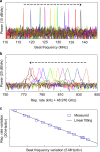Synthesized soliton crystals
- PMID: 34039968
- PMCID: PMC8154952
- DOI: 10.1038/s41467-021-23172-2
Synthesized soliton crystals
Abstract
Dissipative Kerr soliton (DKS) featuring broadband coherent frequency comb with compact size and low power consumption, provides an unparalleled tool for nonlinear physics investigation and precise measurement applications. However, the complex nonlinear dynamics generally leads to stochastic soliton formation process and makes it highly challenging to manipulate soliton number and temporal distribution in the microcavity. Here, synthesized and reconfigurable soliton crystals (SCs) are demonstrated by constructing a periodic intra-cavity potential field, which allows deterministic SCs synthesis with soliton numbers from 1 to 32 in a monolithic integrated microcavity. The ordered temporal distribution coherently enhanced the soliton crystal comb lines power up to 3 orders of magnitude in comparison to the single-soliton state. The interaction between the traveling potential field and the soliton crystals creates periodic forces on soliton and results in forced soliton oscillation. Our work paves the way to effectively manipulate cavity solitons. The demonstrated synthesized SCs offer reconfigurable temporal and spectral profiles, which provide compelling advantages for practical applications such as photonic radar, satellite communication and radio-frequency filter.
Conflict of interest statement
The authors declare no competing interests.
Figures






References
-
- Tanabe T, Fujii S, Suzuki R. Review on microresonator frequency combs. Jpn. J. Appl. Phys. 2019;58:SJ0801. doi: 10.7567/1347-4065/ab2aca. - DOI
-
- Gaeta AL, Lipson M, Kippenberg TJ. Photonic-chip-based frequency combs. Nat. Photon. 2019;13:158–169. doi: 10.1038/s41566-019-0358-x. - DOI
-
- Chembo YK. Kerr optical frequency combs: theory, applications and perspectives. Nanophotonics. 2016;5:214–230. doi: 10.1515/nanoph-2016-0013. - DOI
Grants and funding
LinkOut - more resources
Full Text Sources
Other Literature Sources

